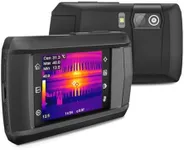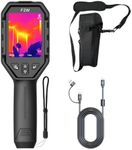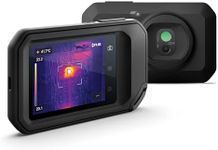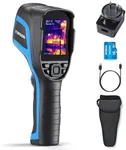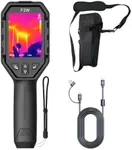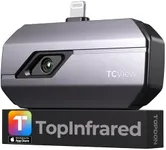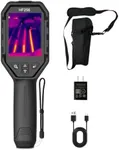Buying Guide for the Best Thermal Image Cameras
Thermal imaging cameras are powerful tools that allow you to see heat signatures and temperature differences in various environments. They are used in a wide range of applications, from building inspections and electrical maintenance to wildlife observation and security. To choose the right thermal imaging camera for your needs, it's important to understand the key specifications and how they impact the camera's performance and suitability for your specific use case.ResolutionResolution refers to the number of pixels in the thermal image. Higher resolution provides more detail and clarity, which is important for identifying small temperature differences and capturing detailed images. Resolutions can range from low (80x60 pixels) to high (640x480 pixels or more). If you need to detect small objects or require detailed images for analysis, opt for a higher resolution. For general use or larger objects, a lower resolution may suffice.
Temperature RangeThe temperature range indicates the minimum and maximum temperatures the camera can measure. This is crucial for ensuring the camera can handle the temperatures you expect to encounter. For example, if you're inspecting industrial equipment that operates at high temperatures, you'll need a camera with a higher maximum temperature range. Conversely, for building inspections or wildlife observation, a lower range may be adequate.
Sensitivity (NETD)Sensitivity, often expressed as NETD (Noise Equivalent Temperature Difference), measures the camera's ability to detect small temperature differences. A lower NETD value indicates higher sensitivity and better performance in detecting subtle temperature variations. If your work requires identifying minute temperature changes, such as in medical diagnostics or detailed inspections, choose a camera with a lower NETD value. For less critical applications, a higher NETD may be acceptable.
Field of View (FOV)Field of View (FOV) describes the extent of the observable area the camera can capture. A wider FOV allows you to see a larger area at once, which is useful for scanning large spaces quickly. However, a narrower FOV provides more detail in a smaller area. Consider your typical use case: for broad area surveillance or inspections, a wider FOV is beneficial. For detailed analysis of specific areas, a narrower FOV is preferable.
Frame RateFrame rate indicates how many frames per second (fps) the camera can capture. Higher frame rates provide smoother video and are important for capturing fast-moving objects or dynamic scenes. Common frame rates range from 9 fps to 60 fps. If you need to monitor moving subjects or require real-time analysis, opt for a higher frame rate. For static inspections or slower processes, a lower frame rate may be sufficient.
Display and ConnectivityThe display quality and connectivity options of a thermal imaging camera affect how you view and share the thermal images. A high-resolution display makes it easier to see details on the camera itself, while connectivity options like Wi-Fi, Bluetooth, or USB allow you to transfer images to other devices for further analysis. Consider how you plan to use and share the images: if you need to quickly share data with a team or analyze images on a computer, ensure the camera has the necessary connectivity features.
Durability and ErgonomicsDurability and ergonomics refer to the camera's build quality and how comfortable it is to use. A rugged, durable camera is essential for harsh environments, while a lightweight, ergonomic design is important for extended use. Think about where and how often you'll be using the camera: for frequent fieldwork or industrial settings, prioritize durability. For long inspection sessions, ensure the camera is comfortable to hold and operate.
